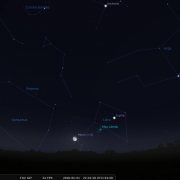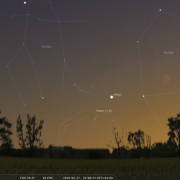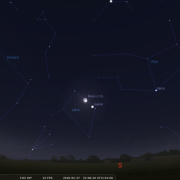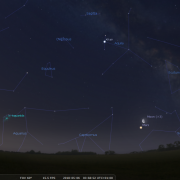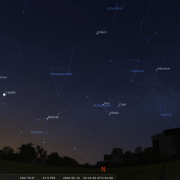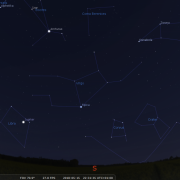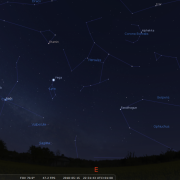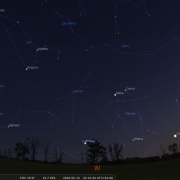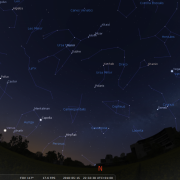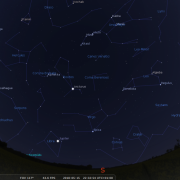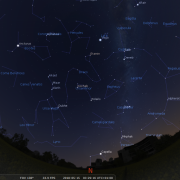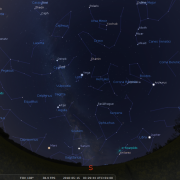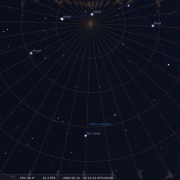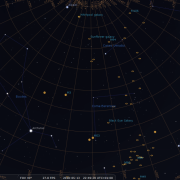Note for Diary: Monthly Meeting will be on Tuesday 1st May and Paul Money Talk on Tuesday 8th May.

Welcome to the WDAS monthly newsletter for May 2018: a digest of the month's latest contributions to our website. Below you'll find Society News, Sky Notes, as well as coming events.
Society News
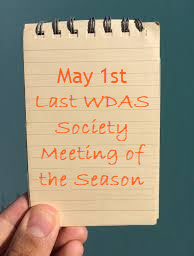 Please don’t forget that our May meeting falls on the first day of the month; Tuesday 1st and just 12 days after the April meeting, which due to the college holidays could not be held until after midmonth!
Please don’t forget that our May meeting falls on the first day of the month; Tuesday 1st and just 12 days after the April meeting, which due to the college holidays could not be held until after midmonth!
With Paul coming up just a week later and with hopefully a busy summer season ahead of us, it would be great to see as many members as possible. The next monthly meeting at the college will not be until October.
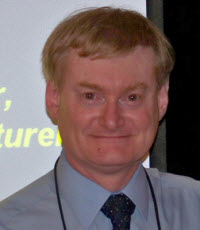 After a 3 year break, all being well Paul will return to Whitby on May 8th to give a presentation on the Voyager. Entitled “Triumphs of Voyager Part 1: Journey to Jupiter / Splendours of Saturn”.
After a 3 year break, all being well Paul will return to Whitby on May 8th to give a presentation on the Voyager. Entitled “Triumphs of Voyager Part 1: Journey to Jupiter / Splendours of Saturn”.
This was planned for last year but due to family illness at the last minute, Paul was unable to make it. Apparently though this talk has now become one of his most popular, along with part 2 of the voyager story. It promises to be a very entertaining evening.
The venue will be the main hall at Whitby College – now called Caedmon College - Normanby campus. There is ample parking and it’s also within easy walking distance from the town.
We are planning on providing some kind of refreshments: sausage rolls, scones, tea and coffee, etc. Admission is £3 (to be agreed) The doors will be open 19:00h for an intended 19:30h start. We would like to see as many members (past and present) as possible, plus anyone who you think may be up for an evening of PM enlightenment. Assistance would also be very welcome setting out chairs – manning the doors, and with the refreshments on the night.
For a PDF poster you can print out at home, please click here: if you can print it off and display somewhere we would be very grateful.
The now annual visit to the Whitby Youth Hostel by visiting pupils from Ayresome Primary School in Middlesbrough coincided with the early Easter holidays, a period which is often susceptible to the weather, and so it proved with cloud and or rain for much of the week. Fortunately Thursday 5th was the exception and clear skies during the day lasted into the evening (more or less), making observation possible for the 3rd year in succession.
On arrival at the hostel area we were met by Libby Lavelle, assistant Head teacher, who had a larger 30 strong group of pupils this year.
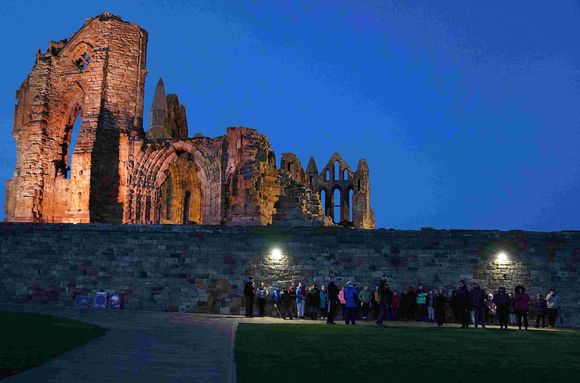
Observations were carried out on the grassed outer approach courtyard area, adjacent to the driveway along to the hostel. Mark, Keith, Lee and Andy L were joined new member Philip this year, and so four scopes were in operation.
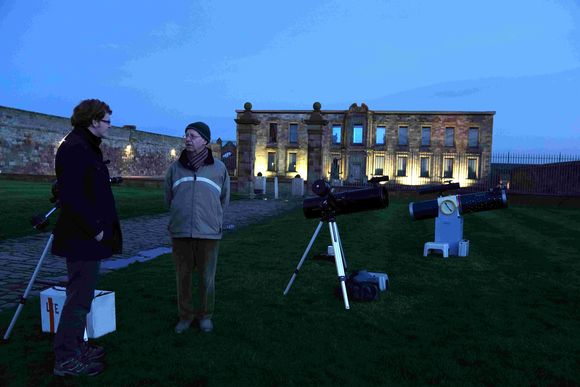
Before observing commenced, Mark and Andy demonstrated the scale solar system along the drive, using both the inflated planets and the light spheres. The only visible planet in the sky was Venus, a brilliant beacon over in the west, and with no moon visible, observations through the scopes were limited to brighter deep sky objects and some star clusters. Mark gave a sky tour with Andy’s laser pointer, having mislaid his (under the throw rug in the rear of his car as it turned out.) The was conducted on the Abbey headland near where the coastguard station used to be, and away from the majority of light spill. By 22:00h the chilly air was starting to take its toll, and so proceedings came to and end.
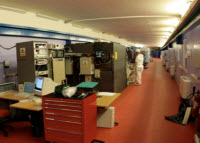 Having not had much feedback regarding which date would be more suited best suited to members, and with the need to clarify a few matters with Sean regarding Health and Safety, a decision will be made at the monthly meeting on May 1st or failing that on the night of Paul Money’s lecture on the 8th.
Having not had much feedback regarding which date would be more suited best suited to members, and with the need to clarify a few matters with Sean regarding Health and Safety, a decision will be made at the monthly meeting on May 1st or failing that on the night of Paul Money’s lecture on the 8th.
The suggested dates are May 9th or 10th or 16th or 17th. It will be a full afternoon visit. Any wishing to go down the mine and given a first had look at the work being carried out in the dark matter facility should attend.
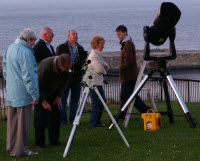 The ‘summer‘ star party season is almost upon us and as per other years we shall be hosting events from the Captain Cook headland area – West Cliff and some from the Archery Green area later in the summer.
The ‘summer‘ star party season is almost upon us and as per other years we shall be hosting events from the Captain Cook headland area – West Cliff and some from the Archery Green area later in the summer.
The dates listed below are for May and June scheduled events, (weather permitting). If the proceeding evening looks a better bet when we get to these dates, that may then become the observing night. If you can join us, (especially if you can bring a telescope along) it would be most appreciated. Hope to see you.
It’s been a pretty frustrating winter and early spring with regard to Sunday evening observatory sessions, averaging out at just over one a month... "poor".
Still, we have managed to get up in the last few weeks, occasions coinciding with the appearance of a first quarter moon in the sky. Mark managed to take a few photos through the eyepiece using just a Lumix compact camera hand held against the eyepiece. Who needs sophisticated equipment?
The Moon, taken at Whitby Observatory by Mark Dawson.
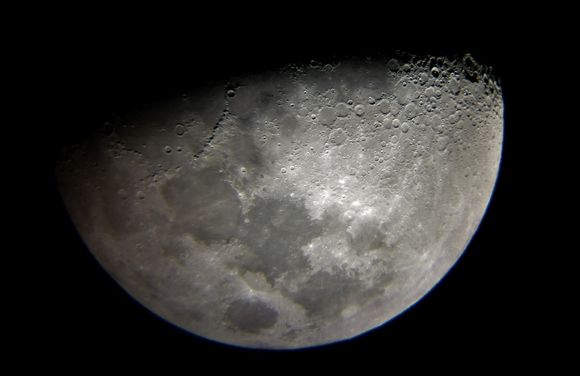
On 25-Mar-2018 at 20:25h
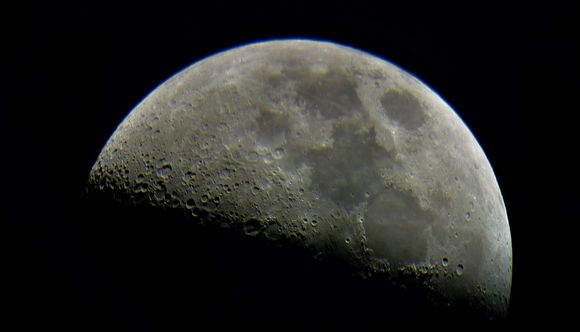
On 22-Apr-2018 at 20:47h
Sky Notes
In this month's Sky Notes:
Planetary Skylights

 As twilight falls, look to the WNW where Venus dominates, the ‘evening star’ by far the most conspicuous object. Venus starts the month between the Hyades and Pleiades star clusters in Taurus. These will be lost in glare by the second week, but Venus continues to keep pace with the sun, not setting until after 23:00h by the month’s end. View on the 17th around 22:00h and look for a very slim Crescent Moon in earthshine residing lower left of Venus. Through a telescope Venus exhibits a definite gibbous phase, but little else is evident beneath the duvet of cloud cover.
As twilight falls, look to the WNW where Venus dominates, the ‘evening star’ by far the most conspicuous object. Venus starts the month between the Hyades and Pleiades star clusters in Taurus. These will be lost in glare by the second week, but Venus continues to keep pace with the sun, not setting until after 23:00h by the month’s end. View on the 17th around 22:00h and look for a very slim Crescent Moon in earthshine residing lower left of Venus. Through a telescope Venus exhibits a definite gibbous phase, but little else is evident beneath the duvet of cloud cover.
 Opposite Venus and rising in the east, Jupiter is the next most conspicuous planet to the eye; (at least it is until later in the summer) The king of the planets comes to opposition on May 9th –rising as the sun sets, crossing the south meridian around midnight. It is certainly visible by 22:00h at the start of May and is already well above the SE horizon as twilight deepens by the end of the month. Unlike Venus, Jupiter shows a wealth of detail when viewed telescopically, especially the darker belts and other atmospheric markings including the great red spot (when orientated toward us). Look for it on the 4th,6th 9th 11th 16th 18th 21st 23rd 28th & 30th around 22:30-23:00h.
Opposite Venus and rising in the east, Jupiter is the next most conspicuous planet to the eye; (at least it is until later in the summer) The king of the planets comes to opposition on May 9th –rising as the sun sets, crossing the south meridian around midnight. It is certainly visible by 22:00h at the start of May and is already well above the SE horizon as twilight deepens by the end of the month. Unlike Venus, Jupiter shows a wealth of detail when viewed telescopically, especially the darker belts and other atmospheric markings including the great red spot (when orientated toward us). Look for it on the 4th,6th 9th 11th 16th 18th 21st 23rd 28th & 30th around 22:30-23:00h.
The attendant Galilean moons present an ever changing configuration from night to night, and are fascinating to follow. Io’s shadow is visible on Jupiter on the following days during late evening, 9th & 25th. Ganymede’s shadow transits Jupiter on May 6th after 23:00h. Look for a small black dot on Jupiter’s disk. The Full Moon resides upper left of Jupiter on the 1st and again on the 27th when the Moon is not quite full.

 Both Mars and Saturn are still early morning objects, visible for the diminishing hours of darkness after midnight. Saturn rises first, a pearly white presence low to the SE by 02:00h. It resides just above the ‘teapot’ asterism in Sagittarius. Telescopically Saturn is currently a glorious spectacle with the rings orientated very favourably. Look also for Saturn’s largest moon; Titan, visible as a small speck just away from the planet. A waning crescent moon lies off the left of Saturn on the 5th.
Both Mars and Saturn are still early morning objects, visible for the diminishing hours of darkness after midnight. Saturn rises first, a pearly white presence low to the SE by 02:00h. It resides just above the ‘teapot’ asterism in Sagittarius. Telescopically Saturn is currently a glorious spectacle with the rings orientated very favourably. Look also for Saturn’s largest moon; Titan, visible as a small speck just away from the planet. A waning crescent moon lies off the left of Saturn on the 5th.
Look the ruddy hue of Mars rising an hour after Saturn. The red planet is finally growing in brightness and by the end of May exceeds Saturn. Mars is moving away from Saturn in Sagittarius and into the following constellation of Capricornus. Telescopically Mars still appears pretty small, but by the month’s end surface detail will become more apparent through larger aperture instruments. We will have to wait another month before matters really alter. On May 6th a crescent moon lies just above Mars.
Meteors

If you are an early riser look out for some shooting stars around May 5/6th when the eta Aquarid meteor shower reaches a peak. This is one of two meteor showers associated with debris particles deposited over time by comet Halley, the other shower being the Orionids seen in late October.
Eta Aquarids have a ZHR (zenith hourly rate) approaching 30, but with Aquarius only just rising in the SE shortly before dawn, observations from the UK are restricted. The radiant of the shower lies close to eta Aquarius, one of the stars making up the "water jar" in the otherwise faint constellation of Aquarius. View around 04:00h when the setting moon will be low to the WSW.
|
Looking North
Mid-May - 22:30h |
Looking South |
|
Looking East
Mid-May - 22:30h |
Looking West
Mid-May - 22:30h |
|
Northern Aspect
Mid-May - 22:30h |
Southern Aspect
Mid-May - 22:30h |
|
Northern Aspect (Before Dawn)
Mid-May - 03:30h |
Southern Aspect (Before Dawn)
Mid-May - 03:30h |
Additional Image Credits:
- Planets and Comets where not otherwise mentioned: NASA
- Sky Charts: Stellarium Software
In our tour of stellar objects crossing the meridian line this month: Charles's Heart, a star in the 'Hunting Dogs' constellation, 'Canes Venatici', and the 'Sunflower Galaxy' a spiral galaxy in the same constellation.
Star: Cor Coroli or ‘Charles's Heart’ in Canes Venatici
Telescope (min. 3" diameter), Easy
Alpha Canum Venaticorum had no name until the 17th century, when it was named Cor Caroli, which means "Charles's Heart". Uncertainty surrounds whether it was named in honour of King Charles I of England, or his son, Charles II, who restored the English monarchy to the throne in 1660. The name was coined in 1660, allegedly by Sir Charles Scarborough, physician to Charles II, who claimed the star seemed to shine exceptionally brightly on the night of Charles II's return to England. In Star Tales, Ian Ridpath points out that the name's first appearance on a star map was in the 1673 chart of Francis Lamb, who labelled it Cor Caroli Regis Martyris ('the heart of Charles the martyred king'), clearly indicating that it was seen as referring to Charles I, so take your pick.
Alpha Canum Venaticorum is a binary star with a combined apparent magnitude of 2.81. The two stars are 19.6 arcseconds apart, which means they are easily resolved in small telescopes. The system lies approximately 110 light years from the Sun. The main component has a spectral type of A0, and is slightly variable (mag 2.84 and 2.98) over a period of 5.47 days and is the prototype of a class of variable stars, the so-called α2 Canum Venaticorum variables. It has a strong magnetic field, some 5,000 times that of Earth's, which are thought to produce huge stars pots causing the variability as the star rotates. The secondary component is a F-type main sequence star. It is considerably fainter than its companion and has an apparent visual magnitude of approximately 5.60. To locate Canes Venatici and its chief star Cor Coroli look below the handle of the Plough. The two main stars in the constellation are relatively distinct. Cor Coroli crosses the south meridian line high up on May 13th at 10:30pm. You will require at least a 3 inch aperture to split Cor Coroli itself. Easy

Star: Cor Coroli in Canes Venatici ('Hunting Dogs), (Image: F Ringwald, Fresno State Campus Obs.)
Galaxy: Sunflower galaxy - M63 or NGC 5055
Telescope, Medium
There are so many galaxies which cross due south at some point in May – you could pick anyone from a couple of dozen. I have chosen
The hunting dogs of Canes Venatici may only be a small constellation, but it contains a number of deep sky objects worthy of attention. One such object M63 or NGC 5055, the Sunflower Galaxy, was discovered by Pierre Méchain, Charles Messier’s friend and colleague, in June 1779, Méchain’s first discovery. Lord Rosse observed the spiral structure of M63 in the mid 19th century, being one of the first galaxies in which structure was clearly seen.
Today’s modern imaging devices reveal the Sunflower galaxy as one of the most beautiful of the messier galaxies. M63 is around 98,000 light years across and contains an estimated 140 billion solar masses. The galaxy has an apparent magnitude of 9.3, lies at a distance of approximately 27 million light years from Earth. It is a member of the M51 Group, a group of galaxies in Canes Venatici that also includes the more famous Whirlpool Galaxy, Messier 51, the brightest galaxy in the group. A Type Ia supernova, SN 1971I, triggered by a violent explosion of a white dwarf, was detected in the galaxy on May 25, 1971. It was observed in one of the spiral arms and reached a peak magnitude of 11.8.
The Sunflower Galaxy has extended features that may have formed as a result of interactions with neighbouring galaxies. The extended structure stretches far beyond the bright extent of the galaxy’s normal spiral arms and more than doubles M63’s true extent. The Galaxy is believed to have a super massive black hole with a mass of up to 30 million
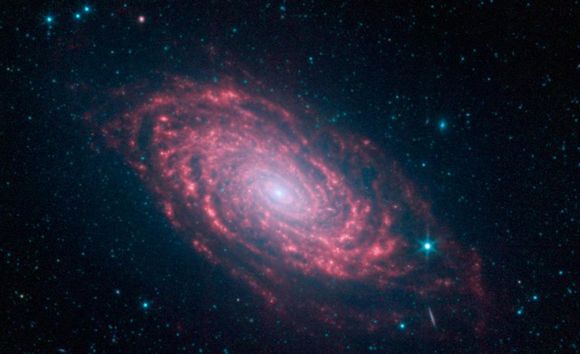
'Sunflower Galaxy' (NGC 5055) (using NASA Spitzer Telescope)
Events
 Observe the night sky with us at the Bruce Observatory, Whitby School
Observe the night sky with us at the Bruce Observatory, Whitby School
Observing Nights are held weather permitting: check for a relatively clear sky before leaving home. If in doubt, Mark can be reached on 07886069339
Please note the college drive gate is now operated via a electronic key code - so anyone wishing to attend must be at the car park at the top of the drive by 19:00hrs - unless an arrival time has been arranged with Mark/Keith.
 Observe the night sky with us at the Bruce Observatory, Whitby School
Observe the night sky with us at the Bruce Observatory, Whitby School
Observing Nights are held weather permitting: check for a relatively clear sky before leaving home. If in doubt, Mark can be reached on 07886069339
Please note the college drive gate is now operated via a electronic key code - so anyone wishing to attend must be at the car park at the top of the drive by 19:00hrs - unless an arrival time has been arranged with Mark/Keith.
 Whitby School - Room H1.
Whitby School - Room H1.
In Members' monthly meetings we usually take a tour of the night sky for the coming month using the Planetarium program. Have talks and presentations on various topics of astronomy/space etc, and discuss future events etc. New members welcome.
 Observe the night sky with us at the Bruce Observatory, Whitby School
Observe the night sky with us at the Bruce Observatory, Whitby School
Observing Nights are held weather permitting: check for a relatively clear sky before leaving home. If in doubt, Mark can be reached on 07886069339
Please note the college drive gate is now operated via a electronic key code - so anyone wishing to attend must be at the car park at the top of the drive by 19:00hrs - unless an arrival time has been arranged with Mark/Keith.
 Observe the night sky with us at the Bruce Observatory, Whitby School
Observe the night sky with us at the Bruce Observatory, Whitby School
Observing Nights are held weather permitting: check for a relatively clear sky before leaving home. If in doubt, Mark can be reached on 07886069339
Please note the college drive gate is now operated via a electronic key code - so anyone wishing to attend must be at the car park at the top of the drive by 19:00hrs - unless an arrival time has been arranged with Mark/Keith.

